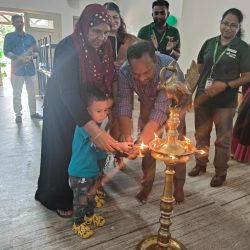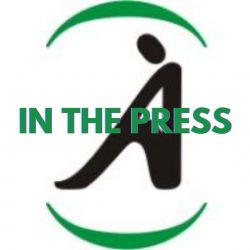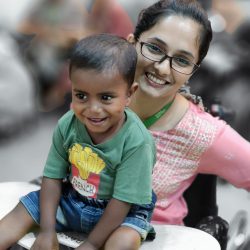April 2012
Dear Friends,
 Here is an update on morphine sales from the Government Opium and Alkaloid Works, the only manufacturer of morphine powder in the country. All of it is used in the country (India exports raw opium) and so this should reflect the consumption trend of morphine in the country.
Here is an update on morphine sales from the Government Opium and Alkaloid Works, the only manufacturer of morphine powder in the country. All of it is used in the country (India exports raw opium) and so this should reflect the consumption trend of morphine in the country.
The peaks in 2000 and 2001 was because of the huge quantity bought by the Government for free distribution to the regional cancer centers (RCCs). We know that most of it was never used. The 2007 peak was a compensatory rise caused by interruptions in supply in the previous two years, and thus was artificial.
Despite these confounding factors, the fact remains that in the past four years, the consumption of morphine in the country has been stable, not rising. This is indeed worrying!
–
Smiles Like This Give Meaning to Our Lives
From The Hindu April 20,2012 – Comfort zone for children with debilitating diseases:
Three-year-old Diya laughed delightfully as Sithara, her physician, tickled her.
‘Again,’ she demanded, holding out her hands. As peals of her laughter rang out, the happiness and relief on her mother’s face was palpable.
Two months ago, little Diya could not sit up or even lift her hands because myopathy had weakened her skeletal muscles. Today, she sits up on her mother’s lap to play with toys, thanks to the efforts at pain management and continued physiotherapy.
- Read the rest of the report by C Maya in The Hindu
It is only a few months since the palliative care service started at S.A.T Hospital in Government Medical College, Trivandrum, but already it is becoming an important part of our lives in Pallium India.
We thank Dr Elizabeth (Superintendent), Dr Lalitha Kailas (Head of Pediatrics), Dr Mohammed Kunju (Head of Pediatric Neurology), Dr Kalpana, Dr Hariprasad and everyone else at S.A.T Hospital for giving us the privilege of working with them.
–
The Kids Gave Us More Than They Got From Us
The Kids Collective (Kuttikkoottam) is formed of more than 150 children whose education Pallium India supports.
They are all children from families where the breadwinner died or is paralyzed; they did not have a lot of brightness in their lives.
Some of our volunteers – Brigadier Oommen, Rema Ramparasad, Leela Devi, Mr Sen and others – felt that they need more than books and school fees and thus was born the Kids’ Collective.
During three days of the summer vacation, 37 of the kids got together for a summer camp where they could learn and play and have a bit of fun. Two days in JMM Center and one day of outing to the zoo and planetarium.

And what amazing talents they displayed! Painters, writers, public speakers – the group had them all. They certainly gave us a treat.
We thank Dr Richa Sood and Dr Amit Sood from the Mayo clinic whose contribution was enough for the conduct of the summer camp. There were many other donations – all that is going to a fund for the continued support from the children. As we write this, a career guidance program for selected children is under way!
Thank you very much donors and thank you JMM Study Center for providing the facilities.
–
Another Step Forward: MD (Palliative Medicine) at Mumbai
Dr. Mary Ann Muckaden, founder of the Department of Palliative Medicine at Tata Memorial Cancer Centre, Mumbai, writes to inform us about their new MD (Palliative Medicine) course:
I am very pleased to inform you that the Tata Memorial Centre has been given the conditional permission to start the first course from the academic session 2012-2013.
Culmination of a lot of hard work by all of us , both here at Tata’s and by the experts who were part of the committee.
I must here acknowledge the efforts of Dr Kailash Sharma, Director, Academics, TMC who has also worked very hard on this.
Hope there are more centres to follow; after 10 years of hard work we should have at least 10 centres in 3 years
Congratulations Dr Mary Ann and team!
–
“Compassion in Action” Brings Together Many in Palliative Care
A few simple words–or even just a silent, supportive presence – can do so much to bring peace to the seriously ill and dying.
This was the essential message of the “Compassion in Action” Conference, held at Santa Clara University in Santa Clara, California, USA on March 30, 2012. The theme of the one-day event was “Providing ‘The Best Care Possible’ Through the End of Life.”
Organized by Hospice of the Valley and Santa Clara University Department of Counseling Psychology, it featured top tier speakers and drew a sold out crowd of professionals and volunteers from the palliative care and hospice fields.
Pallium India-USA, which was a sponsor of the event, provided information to participants about culturally sensitive hospice volunteering, advance care planning, and the situation in India.
Kersi Daruwalla, a longtime hospice volunteer who has recently joined Pallium India-USA, was a stalwart at the table, as were volunteers Zarina Kaji and Sunshine Mugrabi. Kersi had this to say:
This is a type of conference I recommend all of us can attend from time to time. It revitalizes every cell in your body, and helps you understand how simple life and relationships can be. Yet, it is up to us to make this happen.
I can sum this experience up in the following words: It feels good to be a human, caring for another human.
–
Always Good
“Nothing that I did in medical school prepared me for what I do now, at least in terms of Palliative Medicine.”
So writes Donal Kevin Gordon MD in “What I Do and Why I Do It: A Palliative Perspective”, published in the Journal of Palliative Medicine blog.
He describes his work in ways that are both heartening and heart rending – highlighting the emotional challenges and sometimes intense family dynamics he encounters. At the end of the day, he often needs an hour sitting in silence in his living room.
His own personal story is striking as well.
He became a doctor late in life, not entering medical school until the age of 49. Prior to that, he was a professional writer, penning books for major publishers.
Why did he become a doctor? And why palliative medicine?
“Life, in fact, was my only preparation for both,
My mother, dead at 49 of breast cancer; my father, dead at 66, himself of pancreatic cancer; me, my bride, then of only months, then suddenly helping me to raise my 11-year-old brother.
And don’t ask me to tell you about my father’s brothers, lost in their 20s, accidents both;
his mother, dead of cancer in her 40s;
her own mother, killed even younger;
yes, by cancer.”
We come to this work for many different reasons, and even–such as in this case–at different points in our lives.
But as he puts it, the doing of the work is:
“… always good… Always rewarding.
And always, considering with whom I work, in good, very good, company.”
–
National Healthcare Decisions Day Marked
Pallium India-USA plans to join thousands of Americans across the country for National Healthcare Decisions Day on April 16 2012, which brings to the forefront the need to make one’s future healthcare decisions known to family, friends and healthcare providers.
The group will give a formal presentation about how to develop an Advance Healthcare Directive on April 22 at the India Community Center in Milpitas, CA – Learn more and register here.
Advance Healthcare Directives are instructions for your medical decisions if you are not able to speak for yourself. The program is meant to inspire, educate, and empower the community to take charge of its medical care at a crucial time in one’s life.
The San Jose Mercury News coverage of the issue is well worth a read, part of a larger series on the “Cost of Dying,” from reporter Lisa M. Krieger. This piece gets to the heart of why an Advance Healthcare Directive is such an important document:
Cost of Dying: planning for a good death, from advance directive to talking with your family
Bill Newman has seen his share of hospitals. That’s why he plans to never go back.‘If I fall over, just let me go. No 911 guys with paddles. No bells and whistles,’ said the 87-year-old retired high school teacher and double bypass survivor.
[…] Modern medicine prolongs our lives in ways once thought unimaginable. But increasingly, we dwindle into frailty, disease and dementia, ill-prepared for the day when treatment fails us. We can do better, if we make a conscious choice.”
Pallium India-USA’s mission includes educating the community about the crucial need to put one’s wishes on paper so as to ensure the best quality end of life care.
–
WHO Includes Palliative Care as Indicator of Control of Non-Communicable Diseases
 The World Health Organization is evolving global strategy for control of non-communicable diseases. Several international organizations have been working together to include access to palliative care as an important component of the program.
The World Health Organization is evolving global strategy for control of non-communicable diseases. Several international organizations have been working together to include access to palliative care as an important component of the program.
I am glad to report that Pallium India has had its share in persuading the Government of India to support the move, particularly with advocacy by the Pallium India trustee Dr Shalini Vallabhan.
Within the WHO’s recently published consultation document, “A Comprehensive Global Monitoring Framework Including Indicators and a Set of Voluntary Global Targets for The Prevention and Control of Noncommunicabale Diseases,” the following statement appears on page 10 (PDF):
- Table 2: Core indicators for NCD surveillance
- National Health Systems Response
- Access to palliative care assessed by morphine-equivalent consumption of strong opioid analgesics (excluding methadone) per death from cancer
We all know that this statement is not perfect.
- For one thing, morphine consumption is an imperfect indicator of access to palliative care; but we also realize that there is no totally satisfactory indicator.
- We are particularly unhappy that the access to palliative care has been needlessly linked to cancer. We worry that with this sentence, the WHO may be unintentionally conveying to member countries that palliative care is meant only for cancer.
However, we also realize that it has been a huge achievement to have gone thus far and any change in that wording at this stage will be almost impossible.
WHO asks all member countries to respond to this with their comments by April 19. There will be a certain maximum number of indicators and it will need several countries’ support to ensure that the current recommendation will stay in the final form of the document.
This is the time when we must use all our contacts with the Department of Health to persuade them to strongly argue to keep the recommendation in.
–
Weighing the Evidence on Morphine
 Scientific evidence can be misleading if it’s not put into the proper perspective.
Scientific evidence can be misleading if it’s not put into the proper perspective.
A recent classic example: The fear generated when some animal studies showed that morphine may have adverse effects in people with cancer.
Board members from the International Association for Hospice and Palliative Care (IAHPC) weighed the evidence and gave it some context – please read:
In it, the authors Lukas Radbruch, MR Rajagopal (Pallium India chairman), Liliana De Lima, Eduardo Bruera, David Currow, Roberto Wenk, Jim Cleary, Carla Ripamonti and Michael I Bennett, members of the research and scientific committee of the IAHPC point out that recent studies linking opioids to cancer could be misunderstood:
“Two new studies and a commentary published in the April edition of the journal Anesthesiology report a link between opioid drugs used to relieve pain in postoperative and chronic cancer patients and cancer growth and spread.
A press release from the University of Chicago argues that this adds to the growing body of evidence that opioids can stimulate the growth and spread of cancer cells.”
The article concludes:
“The controversy on the published research data indicates that the effect of opioids on cancer growth and spread is rather small – a borderline effect.
The available evidence might also be used as a plea to use opioids regularly, not only for short periods of time, and in effective (high) dosages.
Even if future studies demonstrate that opioids promote cancer growth and spread, this negative effect is far outweighed by the positive effects of adequate relief of suffering.
Unalleviated pain, with its stress response and its adverse effects on energy, appetite and on general well-being would be a far more significant problem, and might also lead to significant comorbidity and shorter survival.”
–
Summit on Breast Health Includes Palliative Care
We are glad to note that palliative and end-of-life care got its place in the Global Summit on Breast Health.
Ms Julia Chase, writing on behalf of Breast Health Global Initiative (BHGI), informs us about the event in October:
Global Summit on International Breast Health
October 3-5, 2012, Vienna
The GLOBAL SUMMIT on INTERNATIONAL BREAST HEALTH: Guidelines for International Breast Health and Cancer Control – Supportive Care and Quality of Life, will be convened by the Breast Health Global Initiative (BHGI), in co-operation with the International Atomic Energy Agency (IAEA), Programme of Action for Cancer Therapy (PACT) of the United Nations, October 3-5, 2012, VIENNA, AUSTRIA.
The Summit will provide a unique open-registration event in the international health community to enhance knowledge of breast health care delivery in low- and middle-income countries (LMCs) from the perspective of Early Disease, Late Disease and End-of-life & Palliative Care.
Scientifically peer-reviewed Guidelines for International Breast Health and Cancer Control – Supportive Care and Quality of Life will result from the 2012 summit, as important and rare medical tools, that will also serve to highlight neglected QOL and palliation issues through mixed-method implementation science research.
The Breast Health Global Initiative (BHGI) is co-sponsored by Fred Hutchinson Cancer Research Center and Susan G. Komen for the Cure®.
For updated information and meeting registration for the Global Summit on International Breast Health, go to www.bhgi.info, or email jchase@fhcrc.org. For sponsorship inquiries, organizations should contact Leslie Sullivan, BHGI Managing Director, lsulliva@fhcrc.org, 206-667-2545.
–
Call for Applications: IASP Trainee Fellowships
 Pain researchers take note!
Pain researchers take note!
The International Association for the Study of Pain (IASP) is taking applications for two trainee fellowships, with grants of US$50,000-$100,000 for up to two consecutive years.
Application Deadline: May 15, 2012
Information about the two grants, as provided by the IASP:
2012 IASP John J. Bonica Trainee Fellowship
- Award: This fellowship offers a stipend of up to US$50,000 per year for 2 consecutive years (up to a total of US$100,000).
- Purpose: Established in 1998 in memory of IASP’s founder, the John J. Bonica Trainee Fellowship supports training in various aspects of pain research to a trainee who is in an early stage of his or her career.
- Eligibility: To be considered for this fellowship, mentors and trainees must have been members of IASP for at least one year before applying.
APPLY HERE…
2012 IASP International Trainee Fellowship funded by the Scan|Design Foundation BY INGER & JENS BRUUN
- Award: This fellowship offers a stipend of up to US$50,000 for one year of training.
- Purpose: Established in 2006, this fellowship supports training in pain research.
- Eligibility: To be considered for this fellowship, mentors and trainees must have been members of IASP for at least one year before applying.
APPLY HERE…
–
April 2012 Issue of Sahayatra Malayalam Newsletter
We are happy to announce that the April 2012 issue of SAHAYATRA, our monthly Malayalam newsletter, is now available for download here…
–
Awarding-winning LIFE Before Death Series continues…
The “LIFE Before Death” series of short movies continue to be released, one every week. They are not only very informative to the public; but also make powerful advocacy material for the palliative care community.
Here are the 5 films released this month:
- #48: Going Out in Style
- #47: A Time to Live
- #46: Movie Soundtrack
- #45: Share The Wealth
- #44: Delivering Dignity
Thank you, Mike Hill and team of Moonshine Movies and thank you, Lien foundation,International Association for the Study of Pain, The Mayday Fund, the Union for International Cancer Control and The Institute for Palliative Medicine at San Diego Hospice International Programs. For more information and to view the entire series, visit the Life Before Death website…
–
PARTING SHOT
 “Top 5 regrets of the dying” a perennial favorite
“Top 5 regrets of the dying” a perennial favorite
Since it was published on February 1 an article in the UK Guardian headlined “Top five regrets of the dying” has consistently been among the top 10 most viewed Life and Style section articles. In fact, for a long period of time, that article was the #1 most read.
The article is based on a blog by a palliative care nurse, Bronnie Ware, called Inspiration and Chai. Having nursed many patients through their last days, she was able to summarize the five most common regrets they experienced, which were as follows:
- I wish I’d had the courage to live a life true to myself, not the life others expected of me.
- I wish I hadn’t worked so hard.
- I wish I’d had the courage to express my feelings.
- I wish I had stayed in touch with my friends.
- I wish that I had let myself be happier
What is truly striking here is the immense popularity of this article. The UK Guardian tells us that the Life and Style section of the paper gets nearly three million (2.97) unique visitors a month. Clearly, it was read and discussed in many households across Britain and around the world.
This should give those of us in the healthcare profession great hope, and also a certain amount of pause. Many physicians, nurses, and social workers work from the basic assumption that the average person doesn’t want to hear anything about death. That thinking or talking about death is too frightening for them. But perhaps this assumption is wrong.
Could it be that doctors are more afraid to think and talk about death than the layman? Many readers of the UK Guardian appear ready and willing to consider their lives in light of the inevitable end that will arrive. They may even want to take steps to actively plan for their own death. So perhaps it is our own discomfort with raising the subject that needs to be addressed. Here’s hoping this opens the way to more, and more honest and direct, conversation about death.
As always, we are deeply grateful for your support, and we invite your responses to any and all that you have read here.











